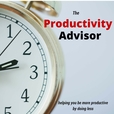
Summary: <br> <a href="http://www.theproductivityadvisor.com/want-a-time-management-tip-to-be-more-productive/">Scheduling</a><br> <br> <br> Putting things in your diary is a great way to carve outsome space and time for them. As any coach will tell you nailing down acommitment to take action on goals is a key part of the activity when workingwith a client. There’s a formula for coaching called the <a href="http://aspirekc.com/wp-content/uploads/2014/12/grow-model_v01.png">GROWmodel</a> and the “W” stands for will or way forward. At this stage in thesession the coach will work hard to get the client to commit time and energy tothe activity they want to work on. Great coaches know that the more specificthe client is about when and where they will take action the greater the chanceof success. Making time and space in your diary to work on something greatlyimproves the chances of you doing actually doing it. <a href="http://www.wb.psu.edu/Documents/StudentServices/time.pdf">Universitiesand educational institutes</a> already share the benefits of scheduling withtheir students to help them avoid cramming.<br> <a href="http://www.theproductivityadvisor.com/urgent-does-not-always-mean-important/">Urgent vs. Important</a><br> <br> Urgent tasks often feel like they are important, but oftenthey are not. The problem with urgent tasks is that they often demand much ourattention and they often have a looming deadline and a sense of pressure. Theirurgency does not give us the space to do our best work and they also requiremuch moving round of other projects and activities to accommodate them. Urgenttasks come with a heavy price when it comes to being effective and productive.Spending time on urgent activities means there is never time to focus on thestrategic, the planning, the meaty important stuff that means the most to us. Thistool is often referred to as the <a href="http://www.eisenhower.me/about">Eisenhowerdecision matrix</a> – it takes its name from Dwight D. Eisenhower, President ofthe United States. This is a great tool to use when planning where to spendtime and focus. By moving away from urgent tasks we create space to work on thethings that are really important.<br> <br> <br> <br> <br> <a href="http://www.theproductivityadvisor.com/time-management-tip-get-ahead/">Sowing the Seeds to Success</a><br> <br> If you are familiar with productivity improvement processesyou may be familiar with something called “set up reduction”. It’s used in allsort of industries to enable production to keep flowing as smoothly as possiblewithout having to stop and get set up for the next batch, line, patient oractivity. One of the simplest ways to employ this technique in our workinglives is to get ready for our working day the day/night before. It’s verysimple to do. Simply clear your desk of anything that doesn’t relate to themost important task you will be working on first. Work on that task first anddo nothing else for 45-90 minutes – no phone calls, emails or distractions. BrianTracy calls this technique <a href="http://play.simpletruths.com/movie/eat-that-frog/">“eating frogs”.</a> It’sa memorable way to make sure you get your most important task done first andit’s a fantastic way to feel great for the rest of the day too.<br> <br> <br>
